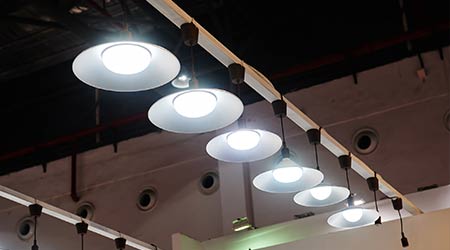 Advances in products and applications offer managers opportunites to plan upgrades that improve lighting and save energy
Advances in products and applications offer managers opportunites to plan upgrades that improve lighting and save energyLED: Lighting Advances Lead to Greater Energy Savings
Recent advances in LED lighting technology now offer managers even more opportunities to improve lighting and save energy.
Part one of a three part series.
The advent of LED technology is spurring massive interest in upgrading existing lighting systems to save energy in institutional and commercial facilities. As a result of this renewed interest, maintenance and engineering managers have a range of options to consider, from replacing lamps to retrofit kits and complete luminaires.
Managers have a straightforward choice. They can do nothing, leaving operating cost savings on the table, or they can take action by replacing lamps and installing automatic controls. They also can go all the way and install a new lighting system that offers greater energy savings potential and other benefits.
Regardless of the scope of the retrofit, its goal should be to save energy while maintaining or improving lighting quality. Lighting has an important job to do, and any upgrade should enhance rather than impair its capabilities. Reducing lighting quality for additional cost savings poses major risks to productivity, the value of which dwarfs the lighting operating budget. Alongside this, managers should consider lighting controls as part of every lighting upgrade.
Controls considerations
Lighting controls automatically reduce lighting in response to occupancy or available daylight, thereby saving energy. Common examples of controls include panelboard additions or retrofits that allow time scheduling, occupancy sensors, and daylight-responsive sensors and controls.
Lighting control strategies can generate 24-38 percent average lighting energy savings, according to the Lawrence Berkeley National Laboratory. While lighting upgrade projects traditionally have involved standalone controls installed to reduce the labor cost, advances in wireless communication and the miniaturization of sensors have put advanced control systems within easier reach for existing buildings.
LED light sources are well-suited to control. Unlike high-intensity discharge lamps, LEDs are instant-on devices, making them suitable for use with occupancy sensors. Unlike fluorescent lamps, frequent lamp switching poses a negligible impact on LED service life, which is beneficial for maintenance. Most luminaires and many retrofit kits feature dimmable drivers as a standard feature or option, meaning the cost of a dimmable ballast no longer inhibits dimming.
Dimming provides flexibility and allows the deeper penetration of lighting control strategies by enabling light reduction in occupied spaces. In the case of LED lighting, dimming can extend product life by reducing LED operating temperatures. Many advanced systems also generate operating data and alerts for energy measurement, savings verification and maintenance. Some products also employ dimming, enabling operators to adjust color temperature — a shade of white light — along with intensity, which is ideal for applications that require color flexibility.
In some cases, simple lighting controls retrofits justify themselves economically with a short payback. In other cases, they do not, which is the reason it is desirable to consider them integral to a comprehensive lighting upgrade.
A lighting retrofit is the ideal time to update building lighting with modern controls. Some local energy codes require the installation of automatic shutoff controls at a minimum. When new luminaires are installed, lighting controls are vital to consider both for the economic opportunity and to comply with applicable energy code requirements.
Related Topics:














